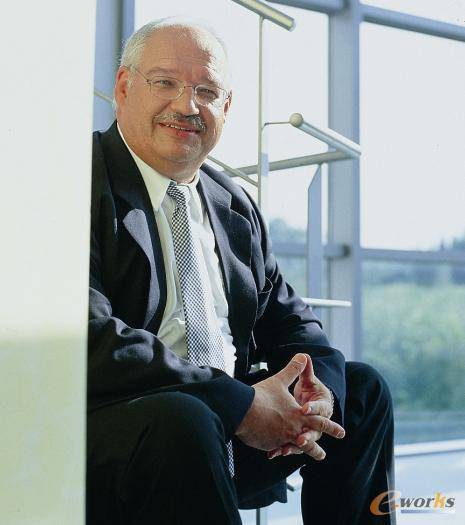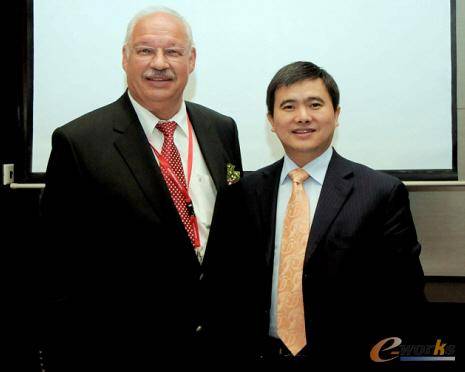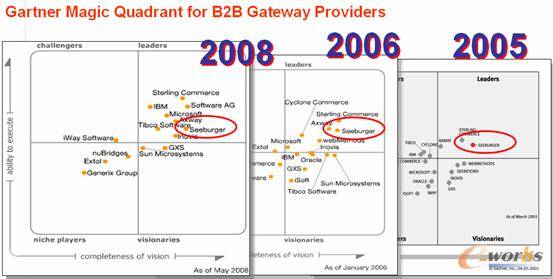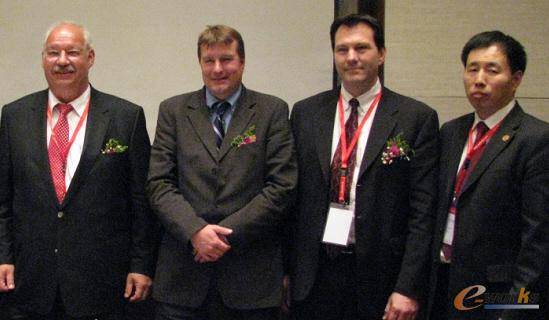The EDI Long March of SEEBURGER
On 18th November, 2008, I interviewed Bernd Seeburger, CEO &Founder of SEEBURGER. Mr. Yang Bin, CEO of Oval Technologies also joined in the interview.
On 18th November, 2008, SEEBURGER signed the partnership with Oval Technologies in Shanghai. On their press conference, I interviewed Bernd Seeburger, CEO & Founder of SEEBURGER. Mr. Yang Bin, CEO of Oval Technologies also joined in the interview.
1. The Kind Uncle “Hamburger”
Although it is the first time for Bernd Seeburger doing routine inspection in China, he still remembered that he traveled in China with his family in 2000. They visit Beijing, Xi’an Guilin and so forth. Bernd likes Chinese food, but it is hard for him to use chopsticks.
Although it is the first time for Bernd Seeburger doing routine inspection in China, he still remembered that he traveled in China with his family in 2000. They visit Beijing, Xi’an Guilin and so forth. Bernd likes Chinese food, but it is hard for him to use chopsticks.
When I asked Mr. Seeburger why he chose his family name as the company’s name, he explained that when he founded the company, it was a one-man show, so he wanted to choose his family name as the company’s name, like Siemens, Bosch and Ford, and he thinks those names with three letters make people confused. And another reason is SEEBURGER sounds like hamburger which is very popular and easily to be remembered. And someone compared SEEBURGER to the middle beef between 2 pieces of bread. Obviously, an important reason is that Mr. Seeburger values the company very much because it is the same as his family name; he has to pay great attention to the recognition and reputation of SEEBURGER.
At dinner party, Mr. Seeburger brought German specialty, a kind of drink like Chinese medicinal liquor to each guest. We all raised glasses to the new milestone of SEEBURGER in China. In addition, SEEBURGER partnered with five big companies on B2B program, such as Guangdong Nortel, Digital China and so on.
At dinner party, Mr. Seeburger brought German specialty, a kind of drink like Chinese medicinal liquor to each guest. We all raised glasses to the new milestone of SEEBURGER in China. In addition, SEEBURGER partnered with five big companies on B2B program, such as Guangdong Nortel, Digital China and so on.

Mr. Bernd Seeburger, CEO & Founder of SEEBURGER
2. The Origin of SEEBURGER
Before Bernd founded SEEBURGER, he worked in IT department of a German automobile supplier. During that work, Mr. Seeburger developed MRPII system based on the company’s ERP system. At that time, a subsidiary of General Motor in Germany, Opel, started information integration of suppliers. So he developed an interface program in assembler to make the order information alternate as soon as possible between Opel and his company. And then it had a big success. Before that, the order was often delayed at least 5 days. In 1985, the PCs came up. And then Mr. Seeburger developed the same software based on PC in Pascal which became the rudiment of B2B Gateway software BIS of SEEBURGER.
In the late 80s, the Japanese auto producers sent a lot of cars to Europe and the European auto manufacturers faced tough challenge. They started to think how to reduce the stock and how to control the cost. At that time, Mr. Seeburger found that the information integration between companies and the EDI technology were widely needed by the auto manufacturers. So he founded SEEBURGER. And he was the only one employee of his company at that time, and his first customer was an auto parts company that manufactures shock absorber, a subsidiary of TyssenKrupp. SEEBURGER was focus on the automobile industry in the first 5 years. In 1993, SEEBURGER made an expansion of EDI solution to the other industries gradually. In 1997, SEEBURGER became an international company and started the Long March of serving the global customers.
Before Bernd founded SEEBURGER, he worked in IT department of a German automobile supplier. During that work, Mr. Seeburger developed MRPII system based on the company’s ERP system. At that time, a subsidiary of General Motor in Germany, Opel, started information integration of suppliers. So he developed an interface program in assembler to make the order information alternate as soon as possible between Opel and his company. And then it had a big success. Before that, the order was often delayed at least 5 days. In 1985, the PCs came up. And then Mr. Seeburger developed the same software based on PC in Pascal which became the rudiment of B2B Gateway software BIS of SEEBURGER.
In the late 80s, the Japanese auto producers sent a lot of cars to Europe and the European auto manufacturers faced tough challenge. They started to think how to reduce the stock and how to control the cost. At that time, Mr. Seeburger found that the information integration between companies and the EDI technology were widely needed by the auto manufacturers. So he founded SEEBURGER. And he was the only one employee of his company at that time, and his first customer was an auto parts company that manufactures shock absorber, a subsidiary of TyssenKrupp. SEEBURGER was focus on the automobile industry in the first 5 years. In 1993, SEEBURGER made an expansion of EDI solution to the other industries gradually. In 1997, SEEBURGER became an international company and started the Long March of serving the global customers.
3. The German Style of SEEBURGER
SEEBURGER has the German company style which is preciseness and steadiness. In the 22 years history of SEEBURGER, it keeps the steady growth. Mr. Seeburger thinks that the improvement speed of the company depends on the professional employees. Because of B2B information integration, the very specific solution that SEEBURGER provides, they need the person who can not only cover IT technology, especially SAP software, but also understand the business process of the company. Mr. Seeburger’s option is that the company will continuously extend market and improve, only if it has the right professional person. Otherwise, he prefers the slow growth than make a detour.
The other problem was the building. Because SEEBURGER grew rapidly, the offices became smaller to the company; the employees had to go to many smaller places to work separately. In 2000, they started to build their own office to make a further improvement.
SEEBURGER today has over 600 employees in the worldwide and becomes a leading provider of global business integration solutions and EDI solution. The company serves more than 7500 customers in over 50 countries and more than 15 industries. Besides, SEEBURGER entered into China in 2006 and founded a subsidiary in China in 2007.
SEEBURGER has the German company style which is preciseness and steadiness. In the 22 years history of SEEBURGER, it keeps the steady growth. Mr. Seeburger thinks that the improvement speed of the company depends on the professional employees. Because of B2B information integration, the very specific solution that SEEBURGER provides, they need the person who can not only cover IT technology, especially SAP software, but also understand the business process of the company. Mr. Seeburger’s option is that the company will continuously extend market and improve, only if it has the right professional person. Otherwise, he prefers the slow growth than make a detour.
The other problem was the building. Because SEEBURGER grew rapidly, the offices became smaller to the company; the employees had to go to many smaller places to work separately. In 2000, they started to build their own office to make a further improvement.
SEEBURGER today has over 600 employees in the worldwide and becomes a leading provider of global business integration solutions and EDI solution. The company serves more than 7500 customers in over 50 countries and more than 15 industries. Besides, SEEBURGER entered into China in 2006 and founded a subsidiary in China in 2007.

Mr. Seeburger and Pei Huang
4. Global Collaboration Meets Seamless Integration
SEEBURGER has constantly focused on business-to-business integration for more than 20 years. When we talked about the global financial crisis, Mr. Seeburger said when the economy goes down, the companies like the automobile industry usually think over how can they reorganize the processes, what can they do better, what can they do faster, how can they reduce the cost. All these make more need of B2B integration; it gives more new businesses to SEEBURGER. From the figure, Mr. Seeburger found that anytime when there is recession, the revenue of SEEBURGER goes up. But when the global economy is booming, those big companies do not have too much time to reorganize the processes. As a result, SEEBURGER often accelerate to extend the global market at that time.
As the development of global economy, SEEBURGER made the expansion from Germany to Western Europe, then U.S., and then Asia-Pacific Area. Mr. Seeburger thinks that there is a great potential in the Asia-Pacific market, especially in China.
The traditional EDI technology is based on VAN. Mr. Seeburger said it’s too much expensive on the VAN service, so he considers the mainstream trend of EDI technology will based on the internet communication. SEEBURGER today is able to provide many B2B integration solutions, for example, internet via TCP/IP, AS2, OFTP (it contains the V2.0, which will be unveiled soon) and RosettaNet. In the meantime, SEEBURGER can support different EDI standards, like EDIFACT in Europe, VDA in German automobile industry, RosettaNet in electronic high tech industry and ebXML. Last year, HP global integrated more than 200 systems into 4 data center; it chose SEEBURGER solution to build global system integration platforms and B2B platforms.
Mr. Seeburger pointed out because of the history and business reasons, the mainstream OEM manufacturers often use their own B2B integration standard. But they can not be the only standard for communication. Therefore, the suppliers need a B2B integration solution to communicate with different OEM manufacturers. So SEEBURGER today provides the business integration platform for seamless, global collaboration based on the different standards.
SEEBURGER built a closer partnership with SAP, providing different kinds of EDI adapters for SAP software. So far, SEEBURGER’s total SAP-certificated adapter library has hit 28. Four years ago, SAP started to sell SEEBURGER’s software that became the important milestone of SEEBURGER development.
Compared with the traditional EDI technology providers, B2B and EAI of SEEBURGER provide more comprehensive and broader adapting solutions, which become the competitive advantage of SEEBURGER gradually.
Mr. Seeburger said:” It is our aim to provide full business integration for each and every company with recurring business processes without them having to rethink their IT structures”.
SEEBURGER has constantly focused on business-to-business integration for more than 20 years. When we talked about the global financial crisis, Mr. Seeburger said when the economy goes down, the companies like the automobile industry usually think over how can they reorganize the processes, what can they do better, what can they do faster, how can they reduce the cost. All these make more need of B2B integration; it gives more new businesses to SEEBURGER. From the figure, Mr. Seeburger found that anytime when there is recession, the revenue of SEEBURGER goes up. But when the global economy is booming, those big companies do not have too much time to reorganize the processes. As a result, SEEBURGER often accelerate to extend the global market at that time.
As the development of global economy, SEEBURGER made the expansion from Germany to Western Europe, then U.S., and then Asia-Pacific Area. Mr. Seeburger thinks that there is a great potential in the Asia-Pacific market, especially in China.
The traditional EDI technology is based on VAN. Mr. Seeburger said it’s too much expensive on the VAN service, so he considers the mainstream trend of EDI technology will based on the internet communication. SEEBURGER today is able to provide many B2B integration solutions, for example, internet via TCP/IP, AS2, OFTP (it contains the V2.0, which will be unveiled soon) and RosettaNet. In the meantime, SEEBURGER can support different EDI standards, like EDIFACT in Europe, VDA in German automobile industry, RosettaNet in electronic high tech industry and ebXML. Last year, HP global integrated more than 200 systems into 4 data center; it chose SEEBURGER solution to build global system integration platforms and B2B platforms.
Mr. Seeburger pointed out because of the history and business reasons, the mainstream OEM manufacturers often use their own B2B integration standard. But they can not be the only standard for communication. Therefore, the suppliers need a B2B integration solution to communicate with different OEM manufacturers. So SEEBURGER today provides the business integration platform for seamless, global collaboration based on the different standards.
SEEBURGER built a closer partnership with SAP, providing different kinds of EDI adapters for SAP software. So far, SEEBURGER’s total SAP-certificated adapter library has hit 28. Four years ago, SAP started to sell SEEBURGER’s software that became the important milestone of SEEBURGER development.
Compared with the traditional EDI technology providers, B2B and EAI of SEEBURGER provide more comprehensive and broader adapting solutions, which become the competitive advantage of SEEBURGER gradually.
Mr. Seeburger said:” It is our aim to provide full business integration for each and every company with recurring business processes without them having to rethink their IT structures”.

SEEBURGER has been positioned in the “Leaders quadrant” in Gartner’s “Magic Quadrant Research Report” for many years
5. The Journey of SEEBURGER in China
As the vigorous development of Chinese manufacturing and gradual popularization of business-to-business integration, SEEBURGER considered that the demand of B2B integration by Chinese companies had gradually matured. Accordingly, SEEBURGER entered into Chinese market in 2006. In the early 2008, SEEBURGER appointed Mr. Zhang Dezheng to serve as General Manager, SEEBURGER China, who has strong B2B domain expertise as well as an extensive background in business development. Mr. Zhang, leading a team, started the journey of SEEBURGER in China. Today they made a big success. SEEBURGER has provided a single, easy-to-maintain solution that uniquely spans the entire supply chain for many international companies, such as, BeijingBenz-DaimlerChrysler Automotive Ltd. (BBDC), FujianDaimler, Murata, Autoliv China and so on. The SEEBURGER system has already automated communications with more than 150 of BBDC’s parts suppliers, firstly implemented JIT/JIS and VMI, and earned Best Supply Chain IT Solution honors from the CHaiNA Supply Chain Council. Recently, SEEBURGER signed with Digital China, providing integration platforms via RosettaNet technology.
Meanwhile, SEEBURGER and Oval Technologies, INC. worked on building a strategic partnership of cooperation. Oval will integrate SEEBURGER B2B and EDI technology into its own Oval EAI supply chain integration strategy.
As the vigorous development of Chinese manufacturing and gradual popularization of business-to-business integration, SEEBURGER considered that the demand of B2B integration by Chinese companies had gradually matured. Accordingly, SEEBURGER entered into Chinese market in 2006. In the early 2008, SEEBURGER appointed Mr. Zhang Dezheng to serve as General Manager, SEEBURGER China, who has strong B2B domain expertise as well as an extensive background in business development. Mr. Zhang, leading a team, started the journey of SEEBURGER in China. Today they made a big success. SEEBURGER has provided a single, easy-to-maintain solution that uniquely spans the entire supply chain for many international companies, such as, BeijingBenz-DaimlerChrysler Automotive Ltd. (BBDC), FujianDaimler, Murata, Autoliv China and so on. The SEEBURGER system has already automated communications with more than 150 of BBDC’s parts suppliers, firstly implemented JIT/JIS and VMI, and earned Best Supply Chain IT Solution honors from the CHaiNA Supply Chain Council. Recently, SEEBURGER signed with Digital China, providing integration platforms via RosettaNet technology.
Meanwhile, SEEBURGER and Oval Technologies, INC. worked on building a strategic partnership of cooperation. Oval will integrate SEEBURGER B2B and EDI technology into its own Oval EAI supply chain integration strategy.
6. Postscript
SEEBURGER has focused on business-to-business integration and flourished for more than 20 years. As Mr. Seeburger pointed out, “all-in-one” strategy will be more popular in companies and there will be more collaboration among enterprises in the future. Consequently, SEEBURGER will have a fine prospect of rapid development in this domain.
SEEBURGER has focused on business-to-business integration and flourished for more than 20 years. As Mr. Seeburger pointed out, “all-in-one” strategy will be more popular in companies and there will be more collaboration among enterprises in the future. Consequently, SEEBURGER will have a fine prospect of rapid development in this domain.

SEEBURGER leadership team(from left to right: Mr. Seeburger, CEO; Henrik Heidemann, VP; James Hatcher, President in China; Zhang Dezheng, General Manager in China)
Recorder&Editor: Sophie Shi ss@e-works.net.cn








